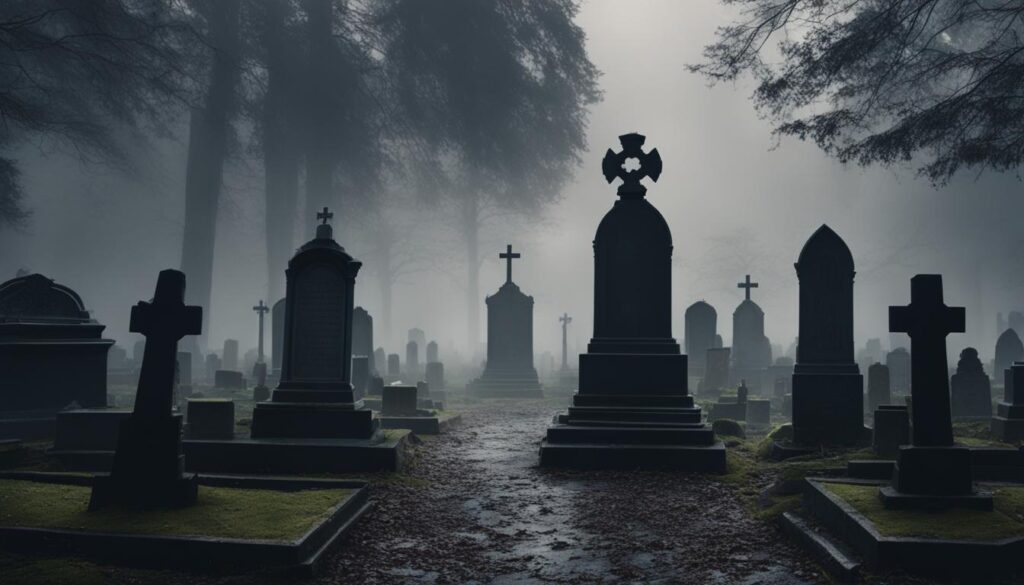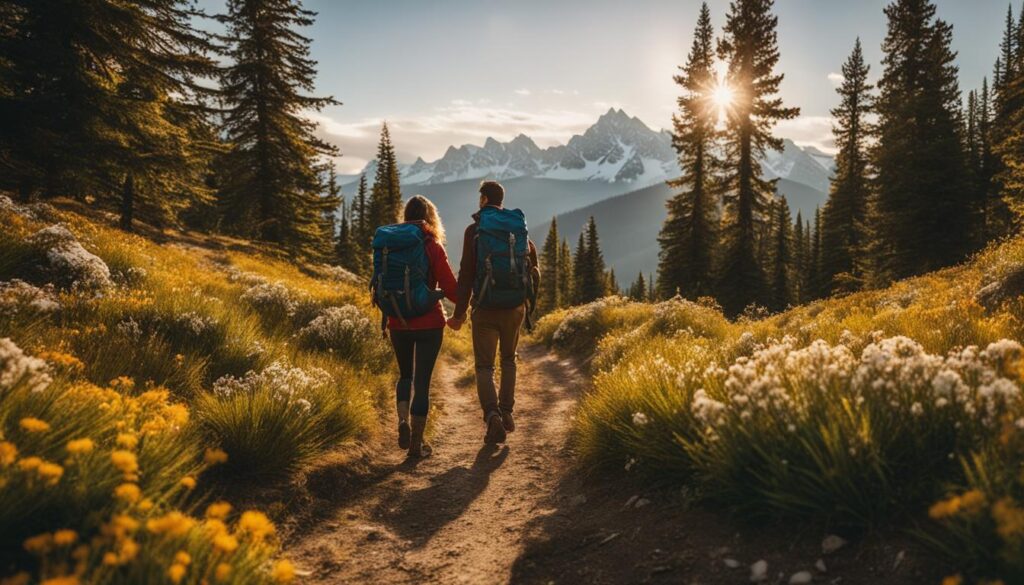We may earn money or products from the companies mentioned in this post.
When a loved one passes away, ensuring they are laid to rest in an appropriate and respectful manner is important for many. Throughout the years, Americans have developed unique burial customs, funeral traditions, and interment practices that reflect their cultural and personal beliefs.
In this comprehensive guide, we will take you on a journey into the world of burial and interment practices in the United States. We will explore the evolution of these practices over time and discuss their cultural significance. We will also delve into modern trends, regional variations, and eco-friendly options that have emerged in recent years.
Key Takeaways:
- Understanding the cultural significance of burial and interment practices is important when honoring a loved one’s memory.
- Burial customs have evolved over time and vary across different regions of the United States.
- Traditional funeral traditions play an important role in the grieving process and honoring the deceased.
- Modern trends in burial and interment reflect contemporary attitudes and preferences.
- Eco-friendly and sustainable burial options are becoming more popular as environmental awareness grows.
Historical Overview of Burial Customs
Burial customs in the United States have undergone significant transformation over time. The evolution of these customs is influenced by cultural factors that reflect changes in social attitudes and beliefs.
In the early days of the United States, burial customs aligned with European traditions. People were buried in simple wooden coffins, and graves were marked with headstones or wooden markers. As communities began to grow, so did the importance of cemeteries. Cemetery customs varied by region, with some areas adopting grandiose monuments and elaborate funeral processions.
Throughout the 19th century, the scientific community began to influence burial practices. The study of anatomy and physiology led to the development of embalming, creating new options for preserving the deceased for extended periods. The Civil War also had a significant impact on burial customs, as it led to the creation of national cemeteries and standardized practices for marking graves.
As the 20th century progressed, burial customs became more commercialized. Funeral homes became a common part of communities, offering a range of services including embalming, casket sales, and funeral planning. This shift towards commercialization also led to an increase in cremation as a viable alternative to traditional burial.
Traditional Funeral Traditions
Funerals are a solemn occasion that serves to honor the deceased. Funeral traditions and customs have been passed down through generations and vary based on culture and religion.
Types of Funerals
In the United States, there are several types of funerals, including traditional funerals, memorial services, and celebration of life ceremonies.
| Type of Funeral | Description |
|---|---|
| Traditional Funeral | Includes a viewing, funeral service, and burial or cremation |
| Memorial Service | A service held after the burial or cremation of the deceased |
| Celebration of Life | A service that celebrates the life of the deceased and focuses on positive memories |
Funeral Customs and Traditions
Traditional funerals typically include a viewing, a funeral service, and burial or cremation. The viewing is an opportunity for family and friends to pay their respects to the deceased and their family. During the funeral service, mourners gather to remember the life of the person who has passed away. The service usually includes music, prayers, eulogies, and readings. Burial or cremation follows the funeral service.
“The best way to find yourself is to lose yourself in the service of others.” – Mahatma Gandhi
Funeral customs and traditions vary based on culture and religion. Some common funeral rituals include:
- Dressing the deceased in specific garments or colors
- Placing objects in the casket or coffin with the deceased
- Carrying the casket or coffin to the burial site
- Having a person recite prayers or readings
- Placing flowers on the casket or grave
Funeral Rituals
Funeral rituals serve to comfort those who are grieving and to honor the life of the person who has passed away. Some common funeral rituals include:
- Playing music or singing hymns
- Burning incense or candles
- Reading religious texts or poetry
- Sharing stories and memories of the deceased
- Having a moment of silence for reflection and prayer
Funeral traditions and customs are an important part of the grieving process and help those who are mourning to find comfort and closure.
Modern Trends in Burial and Interment
As society continues to evolve, so do burial and interment practices. While traditional funeral customs still hold significance, new trends have emerged in recent years. These modern approaches reflect changing attitudes and preferences towards death and the grieving process.
Personalization
One of the most significant trends in burial and interment is personalization. More and more individuals are seeking unique ways to honor their loved ones and celebrate their lives. This trend has resulted in a variety of non-traditional burial rituals and cemetery traditions.
For example, some families opt for personalized caskets or urns that reflect their loved one’s personality or hobbies. Others choose to release doves or butterflies at the gravesite as a symbol of their loved one’s spirit soaring free. Some even incorporate technology, such as live streaming the funeral for distant family members to attend virtually.
Green and Sustainable Options
Another trend in modern burial and interment practices is a growing interest in eco-friendly options. As people become more environmentally conscious, they seek alternatives to traditional burial practices that may be harmful to the environment.
Many cemeteries now offer “green burial” options, which typically involve burying the body in a biodegradable casket or shroud and forgoing embalming chemicals. Some individuals choose to have a tree planted on their grave, creating a natural memorial that benefits the environment.
Virtual Memorials
Lastly, with the rise of social media and other digital platforms, virtual memorialization has become an increasingly popular trend. Online memorials allow friends and family to share memories and pay tribute to their loved one from anywhere in the world.
Virtual memorialization can take many forms, such as creating a memorial website or social media page, or even incorporating a loved one’s ashes into a personalized piece of jewelry or artwork.
Modern trends in burial and interment reflect changing attitudes towards death and the desire for personalization and environmental consciousness. As technology continues to advance, we can expect to see even more innovative approaches to honoring the deceased and celebrating life.
Cultural Variations in Burial Practices
When it comes to burial traditions and interment customs, cultural variations can be vast and diverse. In the United States, various communities have unique beliefs and practices when it comes to burying their loved ones.
For instance, Native American burial traditions often involve placing the body in a fetal position, facing the west. The deceased is often buried with items that hold spiritual significance and may include a gift for the spirit world.
Similarly, African American funeral traditions and interment customs fuse Christianity with traditions rooted in African culture. The funeral service involves lively hymns, and the body is often dressed in bright colors to celebrate the life of the deceased.
On the other hand, Jewish burial customs typically involve a quick funeral service that occurs within 24 hours of the death. The body is not embalmed, and it is buried in a simple wooden casket.
Comparative Overview of Burial Traditions Across Different Communities
| Community | Burial Traditions | Interment Customs |
|---|---|---|
| Asian American | The deceased is typically dressed in white and burned in a cremation ceremony | The family may hold a memorial service on the 100th day after death to honor the deceased |
| Hispanic American | The funeral service involves mariachi bands and is often a festive celebration of life | The family may take part in a graveside service where they place flowers and other mementos on the grave |
| Islamic | The body is washed, wrapped in a burial shroud, and buried within 24 hours of death | The deceased is laid to rest facing Mecca, and the gravesite is typically marked with a simple headstone |
These are just a few examples of the diverse burial traditions and interment customs observed across different communities in the United States. Understanding these cultural variations helps promote acceptance and appreciation of different beliefs and practices.
Sustainable and Green Burial Options
As conversations about climate change and environmental conservation take center stage, more people are turning to sustainable and green burial options. These choices reflect a growing concern for preserving the planet and minimizing one’s environmental impact even in death.
One option is natural burial, where the body is prepared without embalming fluids and is buried in a biodegradable casket or shroud. This approach prioritizes the use of natural materials and avoids the use of chemicals that can harm the environment. These burials take place in designated areas of cemeteries or in nature preserves where the land is conserved for the native flora and fauna. Natural burial can offer a spiritual and meaningful connection to the earth, allowing the body to return to the soil and nourish new life.
Another sustainable choice is cremation, which has gained popularity in recent years as a more environmentally friendly option compared to traditional burial. Cremation reduces land use and eliminates the need for embalming fluids while also using less energy and resources. Some people choose to scatter the ashes in nature or in a designated scattering garden. Others keep the urn at home or bury it in a biodegradable container.
Comparison Table of Sustainable and Traditional Burial Options
| Burial Option | Sustainable and Green | Traditional |
|---|---|---|
| Preparation | Body is not embalmed and is buried in a biodegradable casket or shroud | Body is embalmed with chemicals and is buried in a casket |
| Environmental Impact | Reduces land use and doesn’t harm the environment with chemicals and non-biodegradable materials | Can lead to groundwater contamination and uses non-biodegradable materials |
| Cost | Can be less expensive due to the use of natural materials and less elaborate caskets | Can be more expensive due to the use of embalming and elaborate caskets |
While sustainable and green burial options may not be as widely practiced as traditional burial customs, they offer a meaningful and personal way to honor the deceased while also contributing to environmental conservation efforts. By exploring these alternative practices, individuals and communities can make informed decisions about their end-of-life plans and contribute to a more sustainable future in the process.
Burial and Interment Rituals Across Different Regions
Funeral rituals and burial customs can vary significantly from region to region in the United States. These variations often reflect the cultural and historical background of the communities in those areas.
The South
In Southern states, funerals are often viewed as a celebration of life rather than a somber occasion. Family and friends come together to honor the deceased with food, music, and storytelling. Open-casket viewings are common, and guests are expected to wear formal attire. It’s also customary to bring flowers and other gifts to the funeral home or church.
The Midwest
In the Midwest, funerals are typically more formal and somber than in the South. Often held in a church, the service includes prayers, hymns, and readings from the Bible. The casket may be open or closed depending on the family’s preference. After the funeral, guests may gather for a meal or reception to offer condolences and support to the family.
The Northeast
Funerals in the Northeast are often more private affairs, with only close family and friends in attendance. The service may be held in a funeral home or church, and may include a eulogy, readings, and music. Flowers and other tributes are usually sent directly to the funeral home or family’s home instead of being brought to the service. Burials in this area often take place in tightly packed cemeteries due to limited space.
The West
Funerals in the West tend to be more informal and modern, incorporating personal touches and technology. The service may be held in a non-traditional venue such as a park or beach, and may feature multimedia presentations or live streaming for guests unable to attend in person. Green burials and scattering of ashes are also becoming more popular in this region.
Native American Communities
Native American communities have a rich history of burial and interment practices that vary by tribe and region. Some tribes practice burial, while others practice cremation, and some may combine the two. Funerals often involve rituals and ceremonies that honor the deceased and their connection to the community and the natural world.
The way we bury our dead is reflective of our culture and our relationship with the natural world.” – Native American Elder
Conclusion
Exploring burial and interment practices and their cultural significance has been an eye-opening experience. From traditional funeral customs to modern trends and sustainable options, we have gained a comprehensive understanding of these practices!
Cultural Significance
The practice of burial and interment has been an important component of many cultures and religions for centuries. Understanding the cultural significance of burial customs, funeral traditions, and cemetery traditions allows us to appreciate the depth of meaning behind these practices.
Evolution Over Time
As we explored burial and interment practices, we noticed how these customs have evolved throughout different time periods. From prehistoric times to modern-day, these practices have adapted to reflect changing cultural attitudes and preferences.
Regional Differences
In addition to cultural variations, burial and interment practices can also vary significantly across different regions of the United States. Understanding the unique burial customs and funeral rituals observed in specific areas helps us appreciate the diversity of these practices.
Sustainable and Green Options
With environmental concerns growing, many individuals are choosing sustainable and green burial options. This includes practices such as natural burials and conservation burials which promote environmental conservation.
Final Thoughts
Overall, exploring burial and interment practices has provided us with a comprehensive understanding of the cultural significance of these customs. From traditional funeral rituals to modern sustainable options, these practices have evolved over time to reflect changing cultural attitudes and preferences.
FAQ
What are burial and interment practices?
Burial and interment practices refer to the customs and rituals surrounding the disposal of human remains. These practices vary across cultures and can include burial in cemeteries, cremation, natural burials, and other methods of memorialization.
How have burial customs evolved over time?
Burial customs have evolved significantly throughout history. Early practices often involved simple burials without elaborate ceremonies. Over time, rituals became more complex, incorporating religious and cultural traditions. Today, we see a greater diversity in burial practices, including eco-friendly options and personalized memorial services.
What are traditional funeral traditions?
Traditional funeral traditions are rituals and customs that have been passed down through generations. These can include wake or visitation, funeral services, and graveside ceremonies. They often serve as a way to honor the deceased and provide solace to the grieving family and friends.
What are some modern trends in burial and interment?
Modern trends in burial and interment reflect changing attitudes and preferences. Some examples include personalized funeral services, eco-friendly burials, and alternative memorialization options such as cremation and scattering of ashes. These trends aim to create more meaningful and tailored experiences for both the deceased and their loved ones.
How do burial practices differ across cultures?
Burial practices can vary significantly based on cultural and religious beliefs. Different cultures may have specific rituals, such as embalming, tomb construction, or specific burial garments. Cultural variations also extend to mourning traditions and afterlife beliefs.
What are sustainable and green burial options?
Sustainable and green burial options focus on minimizing environmental impact. These practices often involve using biodegradable materials for coffins or urns, opting for natural burial grounds, and avoiding embalming chemicals. Green burials aim to return the body to the earth in a way that supports ecological balance and conservation.
How do burial and interment rituals differ across regions?
Burial and interment rituals can vary based on regional customs and traditions. Different areas may have specific burial practices, tomb designs, funeral processions, or mourning periods that reflect the local culture. These regional variations add richness to the tapestry of burial customs in the United States.
What have we learned about burial and interment practices in this comprehensive guide?
This comprehensive guide has explored the diverse aspects of burial and interment practices in the United States. We have discussed the historical evolution of customs, traditional funeral traditions, modern trends, cultural variations, sustainable options, and regional rituals. Understanding these practices helps us appreciate their cultural significance and how they have evolved over time.
Affiliate Disclosure: This post may contain affiliate links. If you purchase through our link, we may receive a small commission, but at no additional cost to you. For more information, please see our Disclosure statement.



